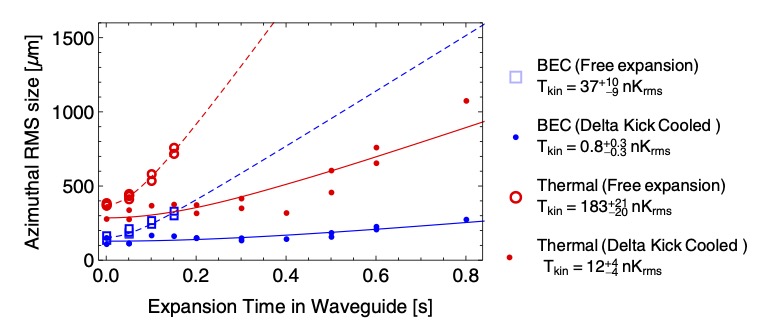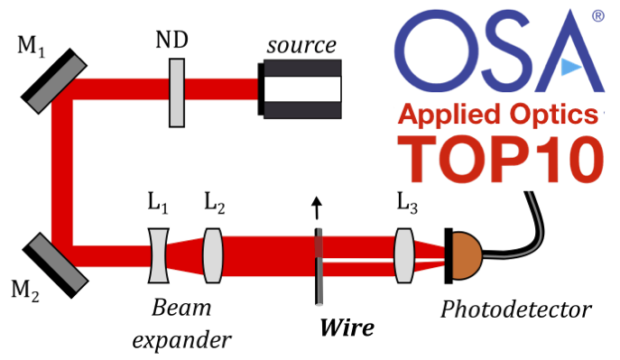Wolf von Klitzing’s colloquium on Matterwave Optics as a Quantum Technology is now available on Youtube.

Cretan Matter Waves Group

Wolf von Klitzing’s colloquium on Matterwave Optics as a Quantum Technology is now available on Youtube.

Phys. Rev. Lett. 126, 170402 (2021)
S. Pandey, H. Mas, G. Vasilakis, and W. von Klitzing
Our latest PRL entitled “Atomtronic Matter-Wave Lensing” has just been published in Physical Review Letters.
It has been featured as a synopsis in Physics.APS.org.
Abstract
In this Letter, we demonstrate magnetogravitational matter-wave lensing as a novel tool in atom-optics in atomtronic waveguides. We collimate and focus matter waves originating from Bose-Einstein condensates and ultracold thermal atoms in ring-shaped time-averaged adiabatic potentials. We demonstrate “delta-kick cooling” of Bose-Einstein condensates, reducing their expansion energies by a factor of 46 down to 800 pK. The atomtronic waveguide ring has a diameter of less than one millimeter, compared to other state- of-the-art experiments requiring zero gravity or free-flight distances of ten meters and more. This level of control with extremely reduced spatial requirements is an important step toward atomtronic quantum sensors.
A synopsis was published in Physics — https://physics.aps.org/articles/v14/s55


Our paper on the detection of gravitational waves using ground-based matterwave interferometers has just been accepted by Classical and Quantum Gravity:
Canuel et al 2020 Class. Quantum Grav. https://doi.org/10.1088/1361-6382/aba80e
Gravitational Waves (GWs) were observed for the first time in 2015, one century after Einstein predicted their existence. There is now growing interest to extend the detection bandwidth to low frequency. The scientific potential of multi-frequency GW astronomy is enormous as it would enable to obtain a more complete picture of cosmic events and mechanisms. This is a unique and entirely new opportunity for the future of astronomy, the success of which depends upon the decisions being made on existing and new infrastructures. The prospect of combining observations from the future space-based instrument LISA together with third generation ground based detectors will open the way towards multi-band GW astronomy, but will leave the infrasound (0.1 Hz to 10 Hz) band uncovered. GW detectors based on matter wave interferometry promise to fill such a sensitivity gap. We propose the European Laboratory for Gravitation and Atom-interferometric Research (ELGAR), an underground infrastructure based on the latest progress in atomic physics, to study space-time and gravitation with the primary goal of detecting GWs in the infrasound band. ELGAR will directly inherit from large research facilities now being built in Europe for the study of large scale atom interferometry and will drive new pan-European synergies from top research centers developing quantum sensors. ELGAR will measure GW radiation in the infrasound band with a peak strain sensitivity of 3.3×10-22/√Hz at 1.7 Hz. The antenna will have an impact on diverse fundamental and applied research fields beyond GW astronomy, including gravitation, general relativity, and geology.

G. Drougakis, K. G. Mavrakis, S. Pandey, G. Vasilakis, K. Poulios, D. G. Papazoglou, and W. von Klitzing
CEAS Space Journal (2019)
http://dx.doi.org/10.1007/s12567-019-00271-x
https://arxiv.org/abs/1907.10425
This approach permits much finer adjustments of the beam direc- tion and position when compared to other beam steering techniques of the same mechanical precision. This results in a much increased precision, accu- racy and mechanical stability. A precision of better than 5μrad and 5 μm is demonstrated, resulting in a resolution in coupling efficiency of 0.1%. To- gether with the added flexibility of an additional beam steering element, this allows a great simplification of the design of the fiber coupler, which normally is the most complex and sensitive element on an optical fiber breadboard. We demonstrate a fiber to fiber coupling efficiency of more than 89.8%, with a stability of 0.2% in a stable temperature environment and 2% fluctuations over a temperature range from 10C to 40C over a measurement time of 14 hours. Furthermore, we do not observe any non-reversible change in the coupling efficiency after performing a series of tests over large temperature variations. This technique finds direct application in proposed missions for quantum experiments in space, e.g. where laser beams are used to cool and manipulate atomic clouds.

Nature 570 205–209 (2019)
S. Pandey, H. Mas, G. Drougakis, P. Thekkeppatt, V. Bolpasi, G. Vasilakis, K. Poulios, and W. von Klitzing
DOI: 10.1038/s41586-019-1273-5


preprint at arxiv.org (1810.07609) (pdf)
Abstract:
When a Bose-Einstein condensate rotates in a purely harmonic potential with an angular frequency which is close to the trap frequency, its many-body state becomes highly correlated, with the most well-known being the bosonic Laughlin state. To take into account that in a real experiment no trapping potential is ever exactly harmonic, we introduce an additional weak, quartic potential and demonstrate that the Laughlin state is highly sensitive to this extra potential. Our results imply that achieving these states experimentally is essentially impossible, at least for a macroscopic atom number.

Our latest paper on the spectroscopy between dressed levels of rubidium atoms is out on arXive (pdf).
Abstract:
We study the hyperfine spectrum of atoms of 87Rb dressed by a radio-frequency field, and present experimental results in three different situations: freely falling atoms, atoms trapped in an optical dipole trap and atoms in an adiabatic radio-frequency dressed shell trap. In all cases, we observe several resonant side bands spaced at intervals equal to the dressing frequency, corresponding to transitions enabled by the dressing field. We theoretically explain the main features of the microwave spectrum, using a semi-classical model in the low field limit and the Rotating Wave Approximation. As a proof of concept, we demonstrate how the spectral signal of a dressed atomic ensemble enables an accurate determination of the dressing configuration and the probing microwave field.

Applied Optics 57 9863 (2018)
M. Mylonakis, S. Pandey, K. G. Mavrakis, G. Drougakis, G. Vasilakis, D. G. Papazoglou, and W. von Klitzing
doi: 10.1364/AO.57.009863
Abstract: We present a simple high-precision method to quickly and accurately measure the diameters of Gaussian beams, Airy spots, and central peaks of Bessel beams ranging from sub-millimeter to many centimeters without special- ized equipment. By simply moving a wire through the beam and recording the relative losses using an optical power meter, one can easily measure the beam diameters with a precision of 1%. The accuracy of this method has been experimentally verified for Gaussian beams down to the limit of a commercial slit-based beam profiler (3%).

AIP Advances 8 095020 (2018)
S. Pandey, H. Mas, G. Drougakis, K. G. Mavrakis, M. Mylonakis, G. Vasilakis, V. Bolpasi, and W. von Klitzing
https://doi.org/10.1063/1.5047839
We present a slave laser highly suitable for the preparation and detection of 87Rb Bose-Einstein condensates (BEC). A highly anti-reflection coated laser diode serves as an optical amplifier, which requires neither active temperature stabilization nor dedicated equipment monitoring the spectral purity of the amplified light. The laser power can be controlled with a precision of 10μW in 70mW with relative fluctuations down to 2 × 10^−4. Due to its simplicity and reliability, this slave laser will be a useful tool for laboratory, mobile, or even space-based cold-atom experiments. By the way of demonstration this slave laser was used as the sole 780nm light-source in the production of 3×10^4 BECs in a hybrid magnetic/dipole trap.

New Journal of Physics 18 075014 (2016)
P. Navez, S. Pandey, H. Mas, K. Poulios, T. Fernholz, and W. von Klitzing
doi: 10.1088/1367-2630/18/7/075014

Figure 2. Experimental realisation of a ring-shaped TAAP waveguide. The radius of the ring is R = 570 μm.
Abstract: We present two novel matter-wave Sagnac interferometers based on ring-shaped time-averaged adiabatic potentials, where the atoms are put into a superposition of two different spin states and manipulated independently using elliptically polarized rf-fields. In the first interferometer the atoms are accelerated by spin-state-dependent forces and then travel around the ring in a matter-wave guide. In the second one the atoms are fully trapped during the entire interferometric sequence and are moved around the ring in two spin-state-dependent `buckets’.

Figure 6. Experimental realisation of arbitrary traps. The fitted radius is 440 μm and 450 μm respectively. Note that (a) and (b) are taken with identical experimental conditions and differ only in the state of the atoms. The axis of the circular rf component and the one of the tilted modulation are not orthogonal.
Corrections to the ideal Sagnac phase are investigated for both cases. We experimentally demonstrate the key atom-optical elements of the interferometer such as the independent manipulation of two different spin states in the ring-shaped potentials under identical experimental conditions.